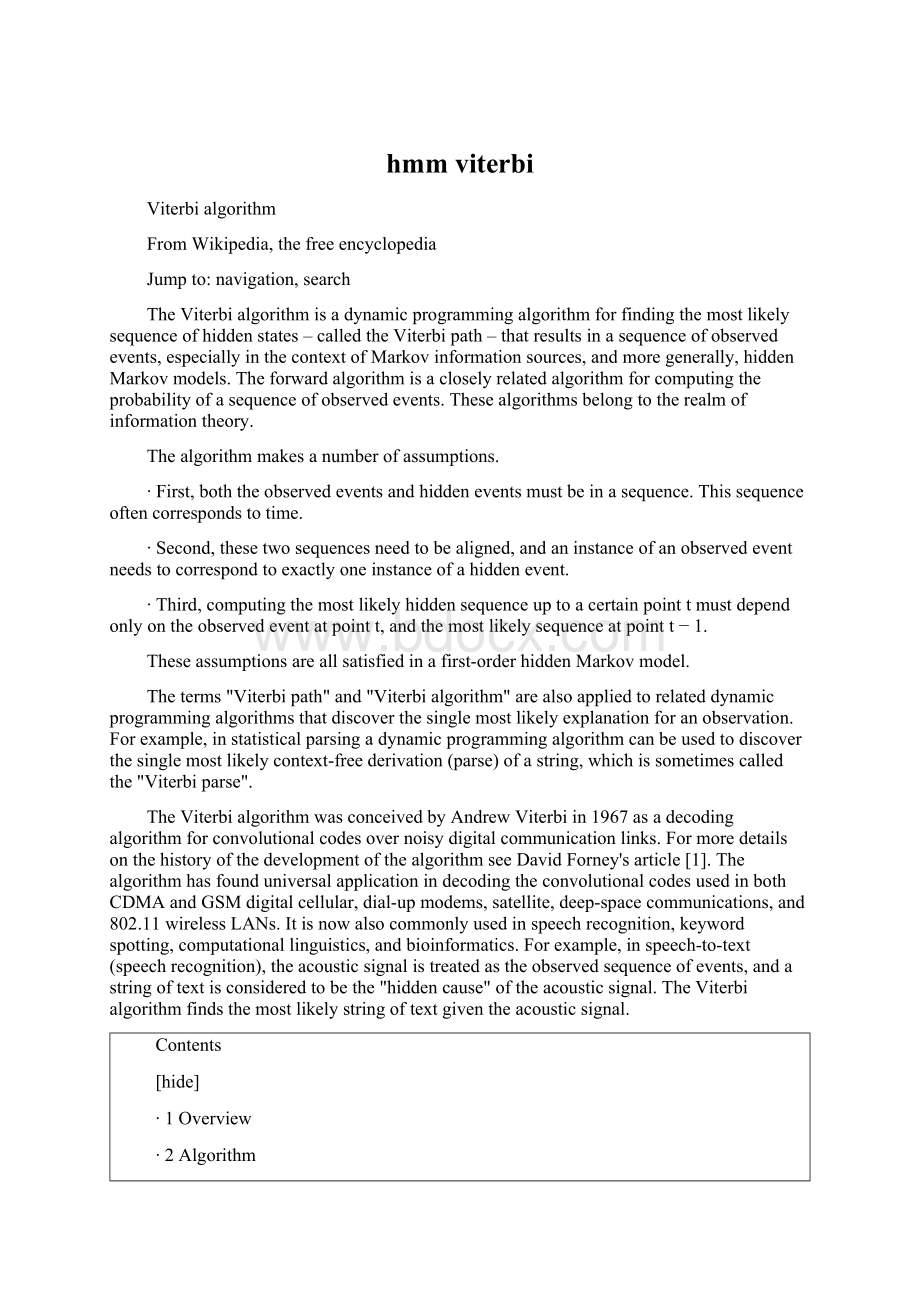hmm viterbi.docx
《hmm viterbi.docx》由会员分享,可在线阅读,更多相关《hmm viterbi.docx(17页珍藏版)》请在冰豆网上搜索。

hmmviterbi
Viterbialgorithm
FromWikipedia,thefreeencyclopedia
Jumpto:
navigation,search
TheViterbialgorithmisadynamicprogrammingalgorithmforfindingthemostlikelysequenceofhiddenstates–calledtheViterbipath–thatresultsinasequenceofobservedevents,especiallyinthecontextofMarkovinformationsources,andmoregenerally,hiddenMarkovmodels.Theforwardalgorithmisacloselyrelatedalgorithmforcomputingtheprobabilityofasequenceofobservedevents.Thesealgorithmsbelongtotherealmofinformationtheory.
Thealgorithmmakesanumberofassumptions.
∙First,boththeobservedeventsandhiddeneventsmustbeinasequence.Thissequenceoftencorrespondstotime.
∙Second,thesetwosequencesneedtobealigned,andaninstanceofanobservedeventneedstocorrespondtoexactlyoneinstanceofahiddenevent.
∙Third,computingthemostlikelyhiddensequenceuptoacertainpointtmustdependonlyontheobservedeventatpointt,andthemostlikelysequenceatpointt−1.
Theseassumptionsareallsatisfiedinafirst-orderhiddenMarkovmodel.
Theterms"Viterbipath"and"Viterbialgorithm"arealsoappliedtorelateddynamicprogrammingalgorithmsthatdiscoverthesinglemostlikelyexplanationforanobservation.Forexample,instatisticalparsingadynamicprogrammingalgorithmcanbeusedtodiscoverthesinglemostlikelycontext-freederivation(parse)ofastring,whichissometimescalledthe"Viterbiparse".
TheViterbialgorithmwasconceivedbyAndrewViterbiin1967asadecodingalgorithmforconvolutionalcodesovernoisydigitalcommunicationlinks.FormoredetailsonthehistoryofthedevelopmentofthealgorithmseeDavidForney'sarticle[1].ThealgorithmhasfounduniversalapplicationindecodingtheconvolutionalcodesusedinbothCDMAandGSMdigitalcellular,dial-upmodems,satellite,deep-spacecommunications,and802.11wirelessLANs.Itisnowalsocommonlyusedinspeechrecognition,keywordspotting,computationallinguistics,andbioinformatics.Forexample,inspeech-to-text(speechrecognition),theacousticsignalistreatedastheobservedsequenceofevents,andastringoftextisconsideredtobethe"hiddencause"oftheacousticsignal.TheViterbialgorithmfindsthemostlikelystringoftextgiventheacousticsignal.
Contents
[hide]
∙1Overview
∙2Algorithm
∙3Example
∙4Javaimplementation
∙5C#Implementation
∙6Extensions
∙7Seealso
∙8Notes
∙9References
∙10Externallinks
[edit]Overview
Theassumptionslistedabovecanbeelaboratedasfollows.TheViterbialgorithmoperatesonastatemachineassumption.Thatis,atanytimethesystembeingmodeledisinsomestate.Thereareafinitenumberofstates.Whilemultiplesequencesofstates(paths)canleadtoagivenstate,atleastoneofthemisamostlikelypathtothatstate,calledthe"survivorpath".Thisisafundamentalassumptionofthealgorithmbecausethealgorithmwillexamineallpossiblepathsleadingtoastateandonlykeeptheonemostlikely.Thiswaythealgorithmdoesnothavetokeeptrackofallpossiblepaths,onlyoneperstate.
Asecondkeyassumptionisthatatransitionfromapreviousstatetoanewstateismarkedbyanincrementalmetric,usuallyanumber.Thistransitioniscomputedfromtheevent.Thethirdkeyassumptionisthattheeventsarecumulativeoverapathinsomesense,usuallyadditive.Sothecruxofthealgorithmistokeepanumberforeachstate.Whenaneventoccurs,thealgorithmexaminesmovingforwardtoanewsetofstatesbycombiningthemetricofapossiblepreviousstatewiththeincrementalmetricofthetransitionduetotheeventandchoosesthebest.Theincrementalmetricassociatedwithaneventdependsonthetransitionpossibilityfromtheoldstatetothenewstate.Forexampleindatacommunications,itmaybepossibletoonlytransmithalfthesymbolsfromanoddnumberedstateandtheotherhalffromanevennumberedstate.Additionally,inmanycasesthestatetransitiongraphisnotfullyconnected.Asimpleexampleisacarthathas3states—forward,stopandreverse—andatransitionfromforwardtoreverseisnotallowed.Itmustfirstenterthestopstate.Aftercomputingthecombinationsofincrementalmetricandstatemetric,onlythebestsurvivesandallotherpathsarediscarded.Therearemodificationstothebasicalgorithmwhichallowforaforwardsearchinadditiontothebackwardsonedescribedhere.
Pathhistorymustbestored.Insomecases,thesearchhistoryiscompletebecausethestatemachineattheencoderstartsinaknownstateandthereissufficientmemorytokeepallthepaths.Inothercases,aprogrammaticsolutionmustbefoundforlimitedresources:
oneexampleisconvolutionalencoding,wherethedecodermusttruncatethehistoryatadepthlargeenoughtokeepperformancetoanacceptablelevel.AlthoughtheViterbialgorithmisveryefficientandtherearemodificationsthatreducethecomputationalload,thememoryrequirementstendtoremainconstant.
[edit]Algorithm
SupposingwearegivenaHiddenMarkovModel(HMM)withstatesY,initialprobabilitiesπiofbeinginstateiandtransitionprobabilitiesai,joftransitioningfromstateitostatej.Sayweobserveoutputs
.Thestatesequence
mostlikelytohaveproducedtheobservationsisgivenbytherecurrencerelations:
[1]
HereVt,kistheprobabilityofthemostprobablestatesequenceresponsibleforthefirstt+1observations(weaddonebecauseindexingstartedat0)thathaskasitsfinalstate.TheViterbipathcanberetrievedbysavingbackpointerswhichrememberwhichstateywasusedinthesecondequation.LetPtr(k,t)bethefunctionthatreturnsthevalueofyusedtocomputeVt,kift>0,orkift=0.Then:
Thecomplexityofthisalgorithmis
.
[edit]Example
Considertwofriends,AliceandBob,wholivefarapartfromeachotherandwhotalktogetherdailyoverthetelephoneaboutwhattheydidthatday.Bobisonlyinterestedinthreeactivities:
walkinginthepark,shopping,andcleaninghisapartment.Thechoiceofwhattodoisdeterminedexclusivelybytheweatheronagivenday.AlicehasnodefiniteinformationabouttheweatherwhereBoblives,butsheknowsgeneraltrends.BasedonwhatBobtellsherhedideachday,Alicetriestoguesswhattheweathermusthavebeenlike.
AlicebelievesthattheweatheroperatesasadiscreteMarkovchain.Therearetwostates,"Rainy"and"Sunny",butshecannotobservethemdirectly,thatis,theyarehiddenfromher.Oneachday,thereisacertainchancethatBobwillperformoneofthefollowingactivities,dependingontheweather:
"walk","shop",or"clean".SinceBobtellsAliceabouthisactivities,thosearetheobservations.TheentiresystemisthatofahiddenMarkovmodel(HMM).
Aliceknowsthegeneralweathertrendsinthearea,andwhatBoblikestodoonaverage.Inotherwords,theparametersoftheHMMareknown.TheycanbewrittendowninthePythonprogramminglanguage:
states=('Rainy','Sunny')
observations=('walk','shop','clean')
start_probability={'Rainy':
0.6,'Sunny':
0.4}
transition_probability={
'Rainy':
{'Rainy':
0.7,'Sunny':
0.3},
'Sunny':
{'Rainy':
0.4,'Sunny':
0.6},
}
emission_probability={
'Rainy':
{'walk':
0.1,'shop':
0.4,'clean':
0.5},
'Sunny':
{'walk':
0.6,'shop':
0.3,'clean':
0.1},
}
Inthispieceofcode,start_probabilityrepresentsAlice'sbeliefaboutwhichstatetheHMMisinwhenBobfirstcallsher(allsheknowsisthatittendstoberainyonaverage).Theparticularprobabilitydistributionusedhereisnottheequilibriumone,whichis(giventhetransitionprobabilities)approximately{'Rainy':
0.57,'Sunny':
0.43}.Thetransition_probabilityrepresentsthechangeoftheweatherintheunderlyingMarkovchain.Inthisexample,thereisonlya30%chancethattomorrowwillbesunnyiftodayisrainy.Theemission_probabilityrepresentshowlikelyBobistoperformacertainactivityoneachday.Ifitisrainy,thereisa50%chancethatheiscleaninghisapartment;ifitissunny,thereisa60%chancethatheisoutsideforawalk.
AlicetalkstoBobthreedaysinarowanddiscoversthatonthefirstdayhewentforawalk,ontheseconddayhewentshopping,andonthethirddayhecleanedhisapartment.Alicehasaquestion:
whatisthemostlikelysequenceofrainy/sunnydaysthatwouldexplaintheseobservations?
ThisisansweredbytheViterbialgorithm.
#HelpsvisualizethestepsofViterbi.
defprint_dptable(V):
print"",
foriinrange(len(V)):
print"%7s"%("%d"%i),
print
foryinV[0].keys():
print"%.5s:
"%y,
fortinrange(len(V)):
print"%.7s"%("%f"%V[t][y]),
print
defviterbi(obs,states,start_p,trans_p,emit_p):
V=[{}]
path={}
#Initializebasecases(t==0)
foryinstates:
V[0][y]=start_p[y]*emit_p[y][obs[0]]
path[y]=[y]
#RunViterbifort>0
fortinrange(1,len(obs)):
V.append({})
newpath={}
foryinstates:
(prob,state)=max([(V[t-1][y0]*trans_p[y0][y]*emit_p[y][obs[t]],y0)fory0instates])
V[t][y]=prob
newpath[y]=path[state]+[y]
#Don'tneedtoremembertheoldpaths
path=newpath
print_dptable(V)
(prob,state)=max([(V[len(obs)-1][y],y)foryinstates])
return(prob,path[state])
Thefunctionviterbitakesthefollowingarguments:
obsisthesequenceofobservations,e.g.['walk','shop','clean'];statesisthesetofhiddenstates;start_pisthestartprobability;trans_parethetransitionprobabilities;andemit_paretheemissionprobabilities.Forsimplicityofcode,weassumethattheobservationsequenceobsisnon-emptyandthattrans_p[i][j]andemit_p[i][j]isdefinedforallstatesi,j.
In